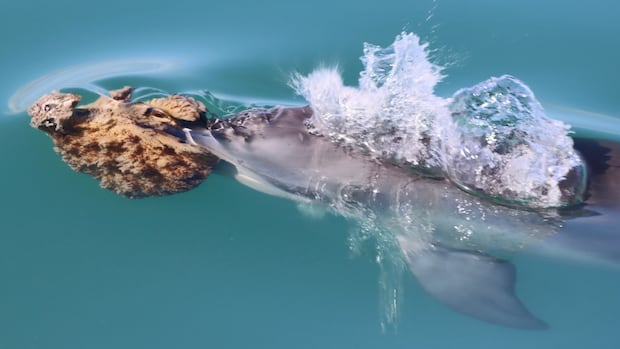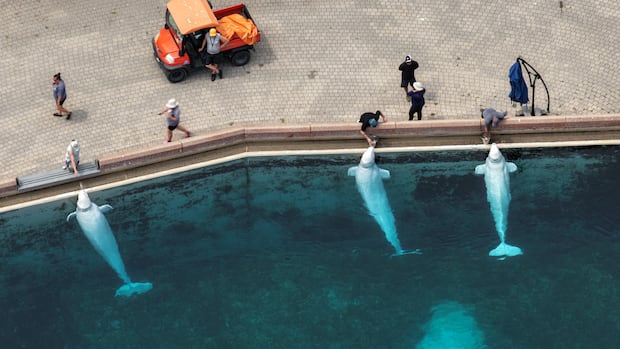As It HappensStudy examines why some dolphins put sea sponges on their noses
In a marine-protected area off the coast of Australia, there are bottleneck dolphins swimming around with sponges on their noses.
But unlike orcas wearing salmon on their heads or chimps putting grass in their ears and anuses, “sponging” isn’t a fashion statement or a cultural trend.
Rather, it’s a sophisticated foraging technique passed down through generations to drudge up tasty snacks from the seafloor.
“It’s likely that sponging arose from a single dolphin having this creative event where they had a sponge on their face and they realized it was really effective for scaring up fish,” Ellen Jacobs, a marine biologist at Denmark’s University of Aarhus, told As it Happens host Nil Kӧksal.
“Then maybe this dolphin had an offspring who saw this was how mom was foraging, so that’s how she’s going to forage, too. And then it kind of snowballs.”
Jacobs is the lead author of a new study, published in Royal Society Open Science this week, that examines the pros and cons of sponging to figure out why the technique is limited to a small population of genetically related dolphins in the marine-protected environment of Shark Bay.
Oddly exclusive
Here’s how sponging works: A dolphin puts a sea sponge on its nose like a glove, then cruises along the sea floor using it rustle up fish hiding among the rocks and shells in the sediment.
“Then the dolphin drops the sponge, grabs the fish, and then picks up the sponge and keeps going,” Jacobs said.
First reported in the 1984, the behaviour has continued through the decades. But only five per cent of the dolphin population studied by the researchers in Shark Bay do it, or roughly 30 dolphins in total.
And it’s strictly a family affair, with calves learning it from their mothers.
“All of the dolphins that we see … sponging are all related matrilineally,” Jacobs said.
The researchers were curious why sponging had not taken off more widely among dolphins. It appears to only spread vertically, from adults to juveniles, and never laterally, from peer to peer or group to group.
Sponging, it turns out, comes with some trade-offs.
First of all, it’s time-consuming. Dolphins who sponge spend more time looking for food than dolphins who use other hunting and foraging techniques, Jacobs said.
What’s more, it’s a complicated skill that takes years to master.
“Sometimes you’ll see juvenile spongers who get frustrated, throw their sponge away and pick up a new one,” Jacobs said. “But as they age, they get more efficient with their sponge use.”
Why is it so hard to learn? The researchers discovered the sponges distort the echolocation that dolphins use to navigate their environments.
Jacobs used an underwater microphone to confirm the dolphins still use echolocation clicks to guide them while sponging. She then modelled the extent of the sound wave distortion from the sponges.
“It’s similar to if you were wearing a pair of glasses with the wrong prescription,” she said. “You’re going to be kind of uncomfortable and everything is going to look a little bit weird, but you can kind of make it through your day, just maybe with a headache.”
Mauricio Cantor, a marine biologist at Oregon State University, who was not involved in the study, likened it to “hunting when you’re blindfolded.”
“You’ve got to be very good, very well-trained to pull it off,” Cantor said.
And not everyone has what it takes to wield the sponge, or the patience to perfect it.
“It takes them many years to learn this special hunting skill [and] not everybody sticks with it,” said Boris Worm, a marine biologist at Dalhousie University in Halifax, who was not involved in the study.
Why bother?
But those who do master the art of sponging reap the benefits of their hard work.
“They can get a lot of fish all year round because the fish that they’re primarily hunting for are not migratory,” Jacobs said. ” And there’s not a lot of dolphins that do it so they don’t have a lot of competition for those fish.”
Earlier research also suggested the fish in the sediment may even be more nutritious than other kinds of fish.
Sponging isn’t the only example of tool use documented among bottleneck dolphins.
In 2020, researchers published a study documenting dolphins teaching each other how to use sea shells to scoop fish into their mouths, a technique they dubbed “shelling” or “conching.”
And just like the spongers, the shellers reside in Shark Bay, a marine protected area off Western Australia.
“Sponging is such a complex interaction between a lot of different parts of the ecosystem, and that’s only possible because it is a very pristine ecosystem,” Jacobs said.
She says dolphins in Shark Bay don’t suffer stresses related to pollution and overfishing like many other dolphins around the world.
“That really gives them the opportunity to be dolphins the way that dolphins should be without anthropogenic impacts,” she said. “It’s a really great opportunity for us to understand: What is a dolphin supposed to be?”







